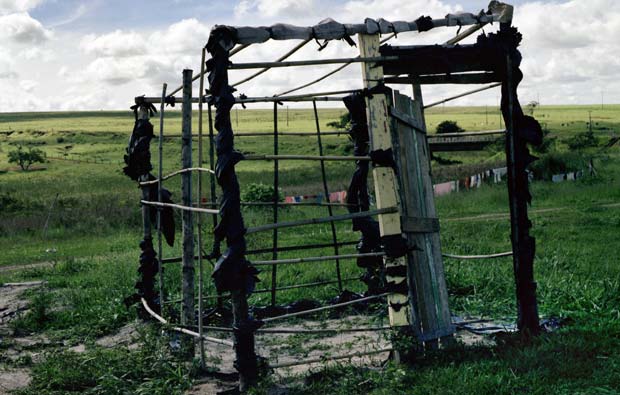

PLAY_gallery
for still and motion pictures presents: |
||
On Saturday, June 17, Paola Salerno will open her first German solo show entitled ‘A consumação’ (consumerism). At PLAY_gallery for still and motion pictures, the Italian artist (who’s based in Paris) will present for the first time an extensive project consisting of photos and a series of videos resulting from a long stay in Brazil. After having exhibited the photo series ‘Calabria’ (1996-2000) and ‘La Chapelle’ (1993-1995) at the Kunst-Werke in ‘Factual Fiction’ – a group show curated by Catherine David, and having taken part to ‘Disobedience’ with the video ‘Lettera di Oreste Scalzone a…’ (2004), Paola Salerno comes back to Berlin, this time with works she made in São Paulo last year.
All along involved with images of global outskirts as subject of her investigation (from Beirut to La Plaine Saint-Denis through the south of Italy) and a committed and rigorous documentary-like approach as mode of operation or conceptual procedure, Paola Salerno tries with her works to bring into focus the relations between artistic practice and ‘impossible politics’, as Brian Holmes once defined her work.
Either with the registration of the monologue of Oreste Scalzone –former leader of Autonomia Operaia and political exile in France- or of a speech of Francesca Salerno –sister of the artist who run for local election in 2003- talking to an absent-minded audience in a small village in Calabria; even with a landscape made of unauthorised houses along the Ionian Sea or of the reconstruction of Beirut, the pragmatic approach of Paola Salerno constantly registers the gap between the legacy of the big political project of the past and the failure of a present lacking perspectives. How to depict this (metaphorical and real) space that has remained empty and abandoned?
Every image by Paola Salerno captures the reality as if it were elsewhere. Somehow, any place or event is always stranger to itself: on them, the traces of a farewell are inscribed. Salerno registers the (social, territorial, cultural, economic) transformation as a loss, as much as Pasolini used to capture anthropological mutations. The gaze of Pasolini as sentimental traveller and committed to the third world seems to be living here again in any landscape, portrait, photographic or video image. Also in Paola Salerno’s work, the real outskirts begin with the Roman suburbs, embrace the Mediterranean Sea and include all the ‘souths’ of the world that –because of their own nature- possess interchangeable features. That is the reason why the faces in her black and white photos captured in a Parisian neighbourhood under a viaduct resemble each other, regardless of their origin (Middle-East, Africa, Asia). And, as well as for Walker Evans’ portraits, even these absent portraits seem to be handed out with no redemption to the judgment of a popular tribunal.
‘The place of consumerism is like an arena, a Roman arena,’ says an anthropologist in the first video of the exhibition ‘A Consumação’, an arena in which the consumers are the gladiators and the fight is fought with brands, corporate images, ritual objects as global market’s products. Paola Salerno leads us inside one of the widest metropolitan areas of the world, São Paulo’s, as inside an arena of global economy. Rather than witnessing once again the conditions of survival in the favelas, Paola Salerno prefers putting up –through a radical gaze- the contradictions of an emerging reality swallowed by consumerism. On the one side DASLU, the luxury Parthenon constructed in 2005 in a wealthy area of São Paulo; on the other, one of the many gated communities like Tamburé’s, where the rich search for protection while the city informally comes up again just beyond their lawns and banana-trees or the remains of a temporary house of a farmer family of Sem Terra in one of the occupied lots. And, finally, a huge garden on a slope of red and fertile earth that slowly reveals itself as an illegal cemetery, until not long ago one of the largest in Brazil. Paola Salerno films it in one of the most poignant one-sequence long shot.
Paola Salerno
Born in 1960 in Catanzaro (Calabria, Italy), lives and works in La Plaine-Saint-Denis (France).
Solo exhibitions: (2002) Le Quartier centre d’art contemporain de Quimper; (2001) Galerie M&T de La Châtre, Foire internationale de l’art contemporain, Paris; (2000) Calabre 1995-1999, Galerie M&T de La Châtre, Paris. Selected group exhibitions: (2005) Disobedience, PLAY_gallery for still and motion pictures, Berlin; (2004) Fabbrica dell’immagine, Académie de France à Rome Villa Medicis, Rome; Empowerment, Cantiere Italia Museo di Villa Croce, Genova; (2003) Fables de l’Identité. Centre national de la photographie, Paris; Prototipi 02. Fondazione Adriano Olivetti, Rome; Faiseurs d’ Histoire. Galerie du théâtre National de Bretagne, Rennes.
PLAY_gallery for still and motion pictures
hannoversche strasse 1 d-10115 berlin
t+49-30-2345 5753 f+49-30-2345 5754
www.pushthebuttonplay.com
opening hours: wed-sat 2-7pm